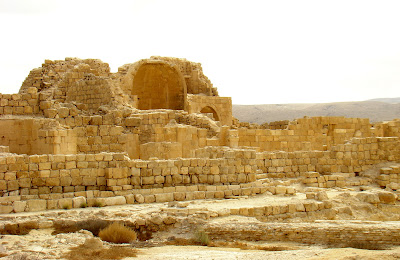After hibernating all summer and refraining from going on trips under the scorching sun, the time has arrived to "get up and go out" again! So yesterday we left Golda in the care of our son and went to visit Megiddo, together with half of my daughter's family, which means her and the two younger children, Noam and Yasmin.
Megiddo is located on a hill of about 60 meters height, at the Carmel ridge, in northern Israel, near Haifa, in the vicinity of a Kibbutz with the same name. And the name Armageddon mentioned in the New Testament derives from Har Megiddo, which is Hebrew and means Mount of Megiddo. This place is OLD, VERY old. Without knowing anything about the history of Megiddo and Shivta, one can see clearly by comparing the photos of both sites, that Megiddo is much much more ancient!
By the year 3000 BCE Megiddo was already a city of great importance. Because of its strategic location it guarded an ancient road which connected Egypt with the land of Mesopotamia in the North. Named
"Derech ha Yam" ( the way along the sea), it became later a very important and strategic trade route of the Roman Empire, called Via Maris.
"Derech ha Yam" ( the way along the sea), it became later a very important and strategic trade route of the Roman Empire, called Via Maris.
But since tools and pottery shards from very early times were discovered, human habitation of the place can be traced back as far as to the year 7000 BCE, which would be the Neolithic Period!
Megiddo was the target of many battles throughout its history, between Egyptian armies and Canaanites, between Egypt and the kingdom of Judah and in our times between the troops of General Allenby and the Turkish army in World War I. The tell is composed of up to 26 layers of ancient ruins and cities, built one above the other over thousands of years. It is uninhabited since 586 BCE, which preserved the ruins quite well, never deranged by newer settlements. So imagine, the upper, undisturbed latest layer is about 2500 years old!!
I don't intend to dig here too much into the history of Megiddo, that would be too complex - there is plenty of information to be found on the Internet. The photos will present an impression of the place, the ancient dwellings will give a hunch of the grandeur and an idea of the importance!
Dwellings from the Israelite period are present. There are two entrance gates, the Canaanite and the Israelite. The Canaanite palace. A northern and a southern palace. Four temples in all, from different periods. A huge granary. A very impressive water system, which can be explored, 187 stairs going down, walking through the tunnel, ascending 87 stairs up on the other side and stepping out at the foot of the tel. We saw stables which could host hundreds of horses, many of the feeding troughs intact, first thought to be from the time of Solomon, but now dated 150 years later to the time of king Ahab. A burial chamber, which was found empty and its date is undetermined. Stairs leading down to a plastered water pool. A circular altar ground from the Canaanite era, where animal bones have been found. Assyrian palaces from the period when Megiddo was the capital city of an Assyrian district.
Many of the finds at Megiddo can be clearly identified and classified, about others the archaeologists and historians argue, have opinions or simply know nothing.
Dwellings from the Israelite period are present. There are two entrance gates, the Canaanite and the Israelite. The Canaanite palace. A northern and a southern palace. Four temples in all, from different periods. A huge granary. A very impressive water system, which can be explored, 187 stairs going down, walking through the tunnel, ascending 87 stairs up on the other side and stepping out at the foot of the tel. We saw stables which could host hundreds of horses, many of the feeding troughs intact, first thought to be from the time of Solomon, but now dated 150 years later to the time of king Ahab. A burial chamber, which was found empty and its date is undetermined. Stairs leading down to a plastered water pool. A circular altar ground from the Canaanite era, where animal bones have been found. Assyrian palaces from the period when Megiddo was the capital city of an Assyrian district.
Many of the finds at Megiddo can be clearly identified and classified, about others the archaeologists and historians argue, have opinions or simply know nothing.
 To visit there is a wonderful experience and time out! The place is beautiful, the view from above is absolutely breathtaking, a big part of Israel :-) can be seen turning around, from the Iron Valley (Wadi Ara) to the Jezreel Valley, the Carmel range, Nazareth, Mount Tavor, the Moreh hill and the Gilboa mountains! Further to the southeast one can spot Jenin and the mountains of Samaria and to the south the city of Um al-Fahm, yes half of Israel almost!
To visit there is a wonderful experience and time out! The place is beautiful, the view from above is absolutely breathtaking, a big part of Israel :-) can be seen turning around, from the Iron Valley (Wadi Ara) to the Jezreel Valley, the Carmel range, Nazareth, Mount Tavor, the Moreh hill and the Gilboa mountains! Further to the southeast one can spot Jenin and the mountains of Samaria and to the south the city of Um al-Fahm, yes half of Israel almost! Many palm trees have been planted long ago on the site, they fit perfectly with the ancient stones, and together with the ruins give you a feeling of being lost in time...
Resources: Wikipedia, the flier distributed at the entrance of the Megiddo National Park, and the vast knowledge of my husband.
Photographs by Uri Eshkar

























































